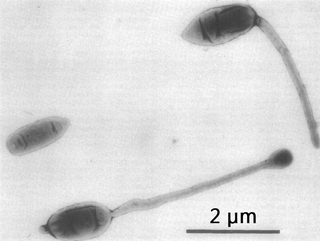The Aurantimonadaceae are a small family of marine bacteria.

The Hyphomicrobiaceae are a family of bacteria. Among others, they include Rhodomicrobium, a genus of purple bacteria.
Rubrobacter is a genus of Actinomycetota. It is radiotolerant and may rival Deinococcus radiodurans in this regard.
Lentisphaerota is a phylum of bacteria closely related to Chlamydiota and Verrucomicrobiota.
Rhodopseudomonas is a genus of bacteria from the family Nitrobacteraceae.
Actinocatenispora is a genus in the phylum Actinomycetota (Bacteria).
Actinopolymorpha is a genus in the phylum Actinomycetota (Bacteria).
Alkalibaculum is a genus in the phylum Bacillota (Bacteria).
The Selenomonadales are an order of bacteria within the class Negativicutes; unlike most other members of Bacillota, they are Gram-negative. The phylogeny of this order was initially determined by 16S rRNA comparisons. More recently, molecular markers in the form of conserved signature indels (CSIs) have been found specific for all Selenomonadales species. On the basis of these markers, the Selenomonadales are inclusive of two distinct families, and are no longer the sole order within the Negativicutes. Several CSIs have also been found specific for both families, Sporomusaceae and Selenomonadceae. Samples of bacterial strains within this order have been isolated from the root canals of healthy human teeth.
Shinella is a genus of bacteria from the family Rhizobiaceae.
Allorhizobium is a genus of Gram-negative soil bacteria. Some species of Allorhizobium form an endosymbiotic nitrogen-fixing association with roots of legumes, while others are known to cause crown gall.
Erythrobacteraceae is a bacterium family in the order of Sphingomonadales.
Melghirimyces is a bacterial genus from the family of Thermoactinomycetaceae.
Acidicapsa is a bacterial genus from the family of Acidobacteriaceae.
Patulibacter is a genus of bacteria from the family Patulibacteraceae.
Pseudokineococcus is a genus of bacteria from the family of Kineosporiaceae.
Peteryoungia aggregata is a gram-negative bacterium of the genus Peteryoungia.
Jatrophihabitans is a genus of Actinomycetota.
Euzebya is a genus of Gram-positive bacteria.
Peteryoungia is a genus of bacteria from the family Rhizobiaceae.
